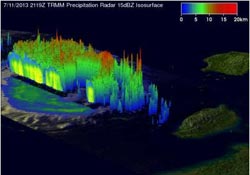NASA caught Soulik's visible eye before making deadly landfall

This TRMM Precipitation Radar 3-D view (from the northwest) shows Typhoon Soulik east of Taiwan. The structure of Soulik's large eye is clearly shown by this TRMM PR slice.<br><br>Credit: NASA/SSAI, Hal Pierce<br>
On July 11, when Typhoon Soulik was approaching Taiwan, NASA and the Japanese Space Agency's Tropical Rainfall Measuring Mission satellite known as TRMM passed overhead in space.
TRMM's Precipitation Radar instrument captured data on rainfall rates, and that data was used to create a 3-D view of the typhoon looking from the northwest. That 3-D view clearly showed Typhoon Soulik's eye when it was east of Taiwan. The 3-D image also revealed the ring of thunderstorms surrounding the eye had rainfall rates of 2 inches/50 mm per hour.
Two days later on July 13, Typhoon Soulik was a category one typhoon when NASA's Terra satellite flew over the storm. Terra's Moderate Resolution Imaging Spectroradiometer (MODIS) instrument captured another image of its eye. On July 13 at 0900 UTC (5 a.m. EDT), Soulik's maximum sustained winds were near 70 knots (80.5/129.6 kph). Those typhoon-strength winds extended 45 nautical miles (51.7 miles/83.3 km) from the center. At that time, Soulik's center had passed Taiwan and was 87 nautical miles (100 miles/161 km) west-northwest of Taipei, Taiwan, near 26.8 north and 120.1 east.
By 1500 UTC (11 a.m. EDT) on July 13, Soulik had made landfall near Fuzhou in southeastern China and was centered near 26.8 north and 119.1 east. After interacting with land, Soulik's maximum sustained winds fell to 60 knots (69 mph/111 kph).
According to the South China Morning Post, Soulik's flooding and landslides have left at least 300 people missing or dead. The southwestern province of Sichuan reported 68 deaths and 179 people missing. Two people died in the Guangdong province, and other parts of China reported 41 deaths and two missing.
Media Contact
More Information:
http://www.nasa.govAll latest news from the category: Earth Sciences
Earth Sciences (also referred to as Geosciences), which deals with basic issues surrounding our planet, plays a vital role in the area of energy and raw materials supply.
Earth Sciences comprises subjects such as geology, geography, geological informatics, paleontology, mineralogy, petrography, crystallography, geophysics, geodesy, glaciology, cartography, photogrammetry, meteorology and seismology, early-warning systems, earthquake research and polar research.
Newest articles

Superradiant atoms could push the boundaries of how precisely time can be measured
Superradiant atoms can help us measure time more precisely than ever. In a new study, researchers from the University of Copenhagen present a new method for measuring the time interval,…

Ion thermoelectric conversion devices for near room temperature
The electrode sheet of the thermoelectric device consists of ionic hydrogel, which is sandwiched between the electrodes to form, and the Prussian blue on the electrode undergoes a redox reaction…

Zap Energy achieves 37-million-degree temperatures in a compact device
New publication reports record electron temperatures for a small-scale, sheared-flow-stabilized Z-pinch fusion device. In the nine decades since humans first produced fusion reactions, only a few fusion technologies have demonstrated…





















